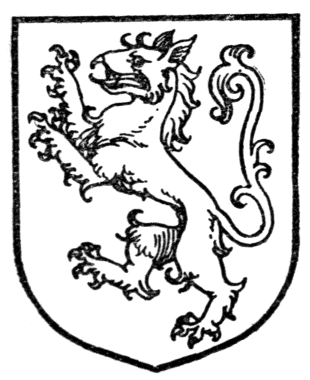Tyger (heraldry) on:
[Wikipedia]
[Google]
[Amazon]
 Tyger, also known as heraldic tiger or tygre, is an imaginary beast used as a
Tyger, also known as heraldic tiger or tygre, is an imaginary beast used as a
Fictitious and symbolic creatures in art
 Tyger, also known as heraldic tiger or tygre, is an imaginary beast used as a
Tyger, also known as heraldic tiger or tygre, is an imaginary beast used as a charge
Charge or charged may refer to:
Arts, entertainment, and media Films
* ''Charge, Zero Emissions/Maximum Speed'', a 2011 documentary
Music
* ''Charge'' (David Ford album)
* ''Charge'' (Machel Montano album)
* ''Charge!!'', an album by The Aqua ...
in heraldry
Heraldry is a discipline relating to the design, display and study of armorial bearings (known as armory), as well as related disciplines, such as vexillology, together with the study of ceremony, rank and pedigree. Armory, the best-known branch ...
.
Name
To distinguish it from the naturally existingtiger
The tiger (''Panthera tigris'') is the largest living cat species and a member of the genus '' Panthera''. It is most recognisable for its dark vertical stripes on orange fur with a white underside. An apex predator, it primarily preys on u ...
, which also occurs in heraldry, the latter is usually blazon
In heraldry and heraldic vexillology, a blazon is a formal description of a coat of arms, flag or similar emblem, from which the reader can reconstruct the appropriate image. The verb ''to blazon'' means to create such a description. The vis ...
ed as a "Bengal tiger".Arthur Fox-Davies
Arthur Charles Fox-Davies (28 February 1871 – 19 May 1928) was a British expert on heraldry. His ''Complete Guide to Heraldry'', published in 1909, has become a standard work on heraldry in England. A barrister by profession, Fox-Davies worke ...
, ''A Complete Guide to Heraldry'', T.C. and E.C. Jack, London, 1909, 191-192, https://archive.org/details/completeguidetoh00foxduoft.
Description
The tyger's body is like that of the real tiger, but lacks stripes. It has the tufted tail of alion
The lion (''Panthera leo'') is a large Felidae, cat of the genus ''Panthera'' native to Africa and India. It has a muscular, broad-chested body; short, rounded head; round ears; and a hairy tuft at the end of its tail. It is sexually dimorphi ...
and a thick mane along the neck like a horse. It has large jaws and a pointed or even horned snout, and its head bears little resemblance to that of any real animal except, distantly, the wolf's. A tyger proper
Proper may refer to:
Mathematics
* Proper map, in topology, a property of continuous function between topological spaces, if inverse images of compact subsets are compact
* Proper morphism, in algebraic geometry, an analogue of a proper map for ...
was in medieval times said to be speckled, later red.
History
As real tigers were unknown to early British heraldists, depictions of this creature were drawn from artists' ideas of this creature that they knew only through secondhand accounts. Consequently, although it originated as an attempt to depict a real creature, the heraldic tyger eventually became highly distinct from the original animal. When real tigers became better known to Europeans, notably through thecolonization of India
Colonial India was the part of the Indian subcontinent that was occupied by European colonial powers during the Age of Discovery. European power was exerted both by conquest and trade, especially in spices.
The search for the wealth and prosper ...
, they began to be depicted in heraldry alongside the traditional heraldic tyger.
Mythology
It is supposed to have its home inHyrcania
Hyrcania () ( el, ''Hyrkania'', Old Persian: 𐎺𐎼𐎣𐎠𐎴 ''Varkâna'',Lendering (1996) Middle Persian: 𐭢𐭥𐭫𐭢𐭠𐭭 ''Gurgān'', Akkadian: ''Urqananu'') is a historical region composed of the land south-east of the Caspia ...
in Persia
Iran, officially the Islamic Republic of Iran, and also called Persia, is a country located in Western Asia. It is bordered by Iraq and Turkey to the west, by Azerbaijan and Armenia to the northwest, by the Caspian Sea and Turkmeni ...
and its swiftness is supposed to have given its name to "tygris", the Persian word for "arrow", and to the swift River Tigris
The Tigris () is the easternmost of the two great rivers that define Mesopotamia, the other being the Euphrates. The river flows south from the mountains of the Armenian Highlands through the Syrian Desert, Syrian and Arabian Deserts, and empti ...
.
If pursued by a tyger, it was supposed to be possible to get away from it by leaving a mirror
A mirror or looking glass is an object that Reflection (physics), reflects an image. Light that bounces off a mirror will show an image of whatever is in front of it, when focused through the lens of the eye or a camera. Mirrors reverse the ...
, which would perplex the tyger, or entrance it in admiration of its own beauty. As a result, tygers are sometimes depicted looking in a mirror.
See also
*The Tyger
"The Tyger" is a poem by the English poet William Blake, published in 1794 as part of his ''Songs of Experience'' collection and rising to prominence in the romantic period. The poem is one of the most anthologised in the English literary cano ...
References
Fictitious and symbolic creatures in art